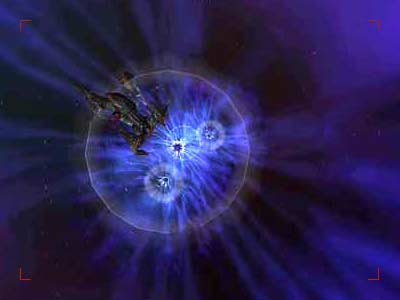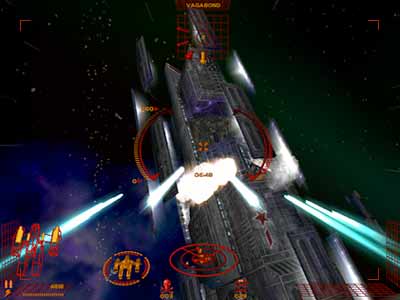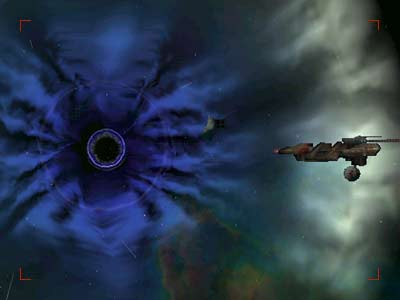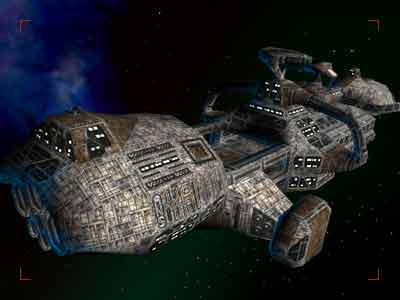Starlancer
Review - space combat for the 22nd Century, and featuring some stunning visuals - can the PC smash return to fame on Dreamcast?

Chivalry for the 22nd Century?
Starlancer is a space combat title, originally developed at Digital Anvil for the PC, and it gives you control of a pilot in the "45th Volunteers", who finds himself caught up in the 22nd Century version of the Cold War. The game offers a progressive storyline and enough opposition to keep you on the go nigh on constantly. As you proceed you gain access to more powerful ships and better weaponry, assuming a position of command and so on. Rather like the X-Wing titles from Lucasarts, each mission you face is a pretty linear affair barring the occasional surprise, and before starting you are treated to a short animated briefing, prior to ship selection, and once over you set off out into space. However unlike X-Wing and its cohorts, Starlancer forces you to improvise. The game helps you on your way, steering you in the right direction when needed, but although faced with an objective, accomplishing it isn't always a case of following straight orders. On that note, one of the game's early drawbacks is that many missions include instructions to shoot down torpedoes before they can blow up your principal carriers, and the game is often quite slow at drawing your attention to them. If fired, you have only a small amount of time to react and take them down, and on two separate occasions I had to replay lengthy sections because the computer didn't warn me of their presence in time, or I was busy cycling through the target roster while they winged their way into the bowels of my ships.

Boombastic
As a concept, Starlancer was always a likely one to be ported to the Dreamcast, but I wasn't terribly convinced that the game would turn out as well as it has. The subtle blend of graphical finesse and console style action is right at home, but the control system of the PC version was pretty complicated, using keyboard and joystick seamlessly. Squeezing such an effective control system onto the relatively simple Dreamcast controller was probably quite an effort, but much to my delight the interface remains intact and just as convenient. Rather like a racing title, the two triggers on the reverse of the pad are used to control your velocity. Unlike other titles though, using the acceleration trigger twice in quick succession fires up the afterburners, while pulling both simultaneously will match your speed with a targeted enemy. It's little double-ups like these on each function that help make sure every option that PC users had is also available to you on you control pad. Although complicated at first, a bit of manual-juggling and common sense will see you through. Navigation through the menus is achieved using a combination of the X and Y buttons and the D-Pad, and whilst fiddling around with those menus, you will notice all sorts of trendy features, like online play, an instant action option (that allows you to race against the clock to kill as many enemies as possible) and things like that.

Cruising
Set against a backdrop of big burly planets (including our own cute little blue one), the interstellar war parties are made up of fighters, bombers, cruisers and even cargo ships. The slightly unrealistic strafe function returns from the PC version, so given a free run, almost-stationary objects like cruisers will have a difficult time targeting you as you bank round them repeatedly, covering them in blast craters. That said, your squad mates' AI is a bit shifty at times, so strafing might not be such a good idea if you're not 100% sure that the coast is clear. It's not just AI either; the game seems to have issues with the order in which you take out certain objectives, too. Blowing up turrets in particular seems to be a fine art. And don't go thinking that just because you've played the mission through once the game will let you use your advanced knowledge to any great effect. I made that mistake, on more than one occasion, by failing to destroy my targets, restarting, then coming back to attack the secondary objective pre-emptively. If you try this, what you will discover is that your onslaught of torpedoes is ineffective until the primary objective is destroyed. Silly, isn't it?

Omissions
One of the things that made Starlancer's online play so captivating on the PC was the co-operative mode, so its absence is a bit of a sore point, but there are standard games of deathmatch and a few derivatives for up to six players simultaneously. The various servers online were a bit sparsely populated, but with any luck they should fill up quite quickly now that the game has been released. Another issue I had with the game was that although incredibly pretty with its luxuriously textured ships and wondrous, gaping black holes, it did seem a little dark at times. Space is fairly dark, in general, but I was rather hoping to be able to see a little more clearly. One might argue that the moody nature of the game helps to emphasize the glorious explosions and the weapon effects, but for me that's no excuse. With those few points made though, that just about wraps up the groaning parade. Elsewhere the game is sublime - it has an excellent soundtrack, not to mention some infectious in-mission chatter from friendly pilots and endearing characters, and lest we forget the inherent replay value. The PC version was pretty ambitious, and although maybe the learning curve will prove a touch steeper than most, with so much to offer it would be hard to run out of reasons to play Starlancer any time this Solstice.
Conclusion
Although marred by a few careless errors and idiosyncratic oddities, Starlancer is a perfectly competent space shooter, and one with enough brunt to keep you coming back for more. The single player game is challenging, and playing multiplayer against other experienced pilots is an exciting experience. Overall, an excellent port, it's just a shame that the original had a few problems. Related Features:- Starlancer Review

